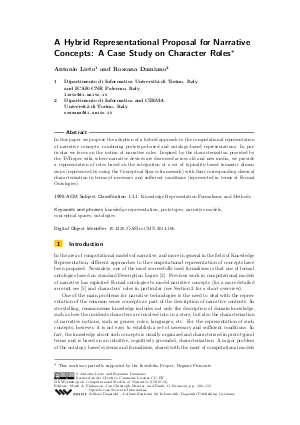A Hybrid Representational Proposal for Narrative Concepts: A Case Study on Character Roles
Authors Antonio Lieto, Rossana Damiano
-
Part of:
Volume:
2014 Workshop on Computational Models of Narrative (CMN 2014)
Part of: Series: Open Access Series in Informatics (OASIcs) - License:
 Creative Commons Attribution 3.0 Unported license
Creative Commons Attribution 3.0 Unported license
- Publication Date: 2014-08-08
File

PDF
OASIcs.CMN.2014.106.pdf
- Filesize: 489 kB
- 10 pages
Document Identifiers
Subject Classification
Keywords
- knowledge representation
- prototypes
- narrative models
- conceptual spaces
- ontologies
Metrics
- Access Statistics
-
Total Accesses (updated on a weekly basis)
0PDF Downloads0Metadata Views
Abstract
In this paper we propose the adoption of a hybrid approach to the computational representation of narrative concepts, combining prototype-based and ontology-based representations. In particular we focus on the notion of narrative roles. Inspired by the characterization provided by the TvTropes wiki, where narrative devices are discussed across old and new media, we provide a representation of roles based on the integration of a set of typicality-based semantic dimensions (represented by using the Conceptual Spaces framework) with their corresponding classical characterization in terms of necessary and sufficient conditions (represented in terms of Formal Ontologies).
Cite As Get BibTex
Antonio Lieto and Rossana Damiano. A Hybrid Representational Proposal for Narrative Concepts: A Case Study on Character Roles. In 2014 Workshop on Computational Models of Narrative. Open Access Series in Informatics (OASIcs), Volume 41, pp. 106-115, Schloss Dagstuhl – Leibniz-Zentrum für Informatik (2014)
https://doi.org/10.4230/OASIcs.CMN.2014.106
BibTex
@InProceedings{lieto_et_al:OASIcs.CMN.2014.106,
author = {Lieto, Antonio and Damiano, Rossana},
title = {{A Hybrid Representational Proposal for Narrative Concepts: A Case Study on Character Roles}},
booktitle = {2014 Workshop on Computational Models of Narrative},
pages = {106--115},
series = {Open Access Series in Informatics (OASIcs)},
ISBN = {978-3-939897-71-2},
ISSN = {2190-6807},
year = {2014},
volume = {41},
editor = {Finlayson, Mark A. and Meister, Jan Christoph and Bruneau, Emile G.},
publisher = {Schloss Dagstuhl -- Leibniz-Zentrum f{\"u}r Informatik},
address = {Dagstuhl, Germany},
URL = {https://drops.dagstuhl.de/entities/document/10.4230/OASIcs.CMN.2014.106},
URN = {urn:nbn:de:0030-drops-46484},
doi = {10.4230/OASIcs.CMN.2014.106},
annote = {Keywords: knowledge representation, prototypes, narrative models, conceptual spaces, ontologies}
}
Author Details
References
-
R. Aylett, M. Vala, P. Sequeira, and A. Paiva. Fearnot!-an emergent narrative approach to virtual dramas for anti-bullying education. LNCS, 4871:202, 2007.

-
F. Baader, D. Calvanese, D. McGuinness, D. Nardi, and P. Patel-Schneider. The Description Logic Handbook. Theory, Implementation and Applications. Cambridge University Press, 2003.

-
Marc Cavazza and David Pizzi. Narratology for interactive storytelling: A critical introduction. In Technologies for Interactive Digital Storytelling and Entertainment, pages 72-83. Springer, 2006.

-
Paul M Churchland. A neurocomputational perspective: The nature of mind and the structure of science. MIT press, 1989.

-
Rossana Damiano and Antonio Lieto. Ontological representations of narratives: a case study on stories and actions. In Finlayson et al. [9], pages 76-93.

-
Jonathan St BT Evans and Keith Ed Frankish. In two minds: Dual processes and beyond. Oxford University Press, 2009.

-
C.R. Fairclough. Story Games and the OPIATE System: Using Case-Based Planning for Structuring Plots with an Expert Story Director Agent and Enacting them in a Socially Simulated Game World. DoctoralThesis, UniversityofDublin-TrinityCollege, 2004.

-
Susan L. Feagin. On Noel Carrol on narrative closure. Philosophical Studies, 135(1):17-25, 2007.

-
Mark A. Finlayson, Bernhard Fisseni, Benedikt Löwe, and Jan Christoph Meister, editors. 2013 Workshop on Computational Models of Narrative, CMN 2013, August 4-6, 2013, Hamburg, Germany, volume 32 of OASICS. Schloss Dagstuhl - Leibniz-Zentrum fuer Informatik, 2013.

-
Gustav Freytag. Die Technik des Dramas. Hirzel, Leipzig, 1863.

-
Marcello Frixione and Antonio Lieto. Representing concepts in formal ontologies: Compositionality vs. typicality effects. Logic and Logical Philosophy, 21(4):391-414, 2012.

-
Marcello Frixione and Antonio Lieto. Towards an extended model of conceptual representations in formal ontologies: A typicality-based proposal. J. Universal Computer Science, 20(3):257-276, 2014.

-
Marcello Frixione and Antonio Lieto. Formal ontologies and semantic technologies: A dual process proposal for concept representation. Philosophia Scientiae, forth.

-
Peter Gärdenfors. Conceptual spaces: The geometry of thought. MIT press, 2004.

-
Pablo Gervás. Propp’s morphology of the folk tale as a grammar for generation. In Finlayson et al. [9], pages 106-122.

-
Pablo Gervás, Belén Díaz-Agudo, Federico Peinado, and Raquel Hervás. Story plot generation based on cbr. Knowledge-Based Systems, 18(4):235-242, 2005.

-
Leo Ghignone, Antonio Lieto, and Daniele P. Radicioni. Typicality-based inference by plugging conceptual spaces into ontologies. In Antonio Lieto and Marco Cruciani, editors, AIC@AI*IA, volume 1100 of CEUR Workshop Proceedings, pages 68-79. CEUR-WS.org, 2013.

-
Algirdas J Greimas. Sémantique structurale. L'Homme, 6(4), 1966.

-
Nicola Guarino. Formal ontology in information systems: Proceedings of the first international conference (FOIS'98), June 6-8, Trento, Italy, volume 46. IOS press, 1998.

-
Daniel Kahneman. Thinking, fast and slow. Macmillan, 2011.

-
Antonio Lieto. Non classical concept representation and reasoning in formal ontologies. PhD thesis, Universita degli studi di Salerno, 2012.

-
Vincenzo Lombardo and Rossana Damiano. Semantic annotation of narrative media objects. Multimedia Tools and Applications, 59(2):407-439, July 2012. 10.1007/s11042-011-0813-2.

-
Edouard Machery et al. Doing without concepts. Oxford University Press Oxford, 2009.

-
Kai Pata. An ontospatial representation of writing narratives in hybrid ecosystem. In DEXA Workshops, pages 87-91, 2010.

-
G. Polti. Les trente-six situations dramatiques. Mercure de France, Paris, 1895.

-
V. Propp. Morphology of the Folktale. University of Texas Press, 1968.

-
Eleanor Rosch and Carolyn B Mervis. Family resemblances: Studies in the internal structure of categories. Cognitive psychology, 7(4):573-605, 1975.

